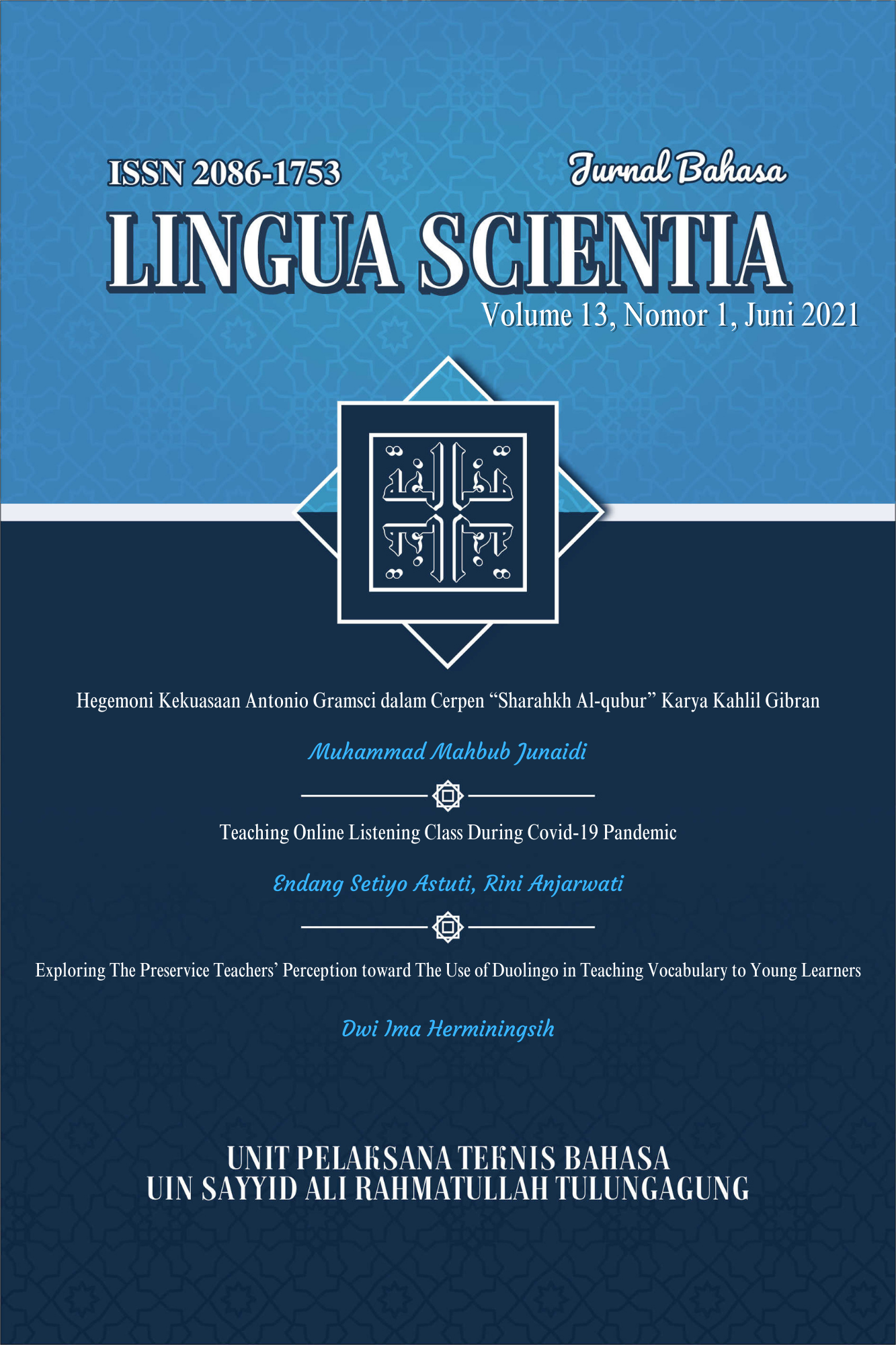STUDENTS’ PERSPECTIVES ON THE PRACTICES OF ONLINE PEER- FEEDBACK IN EFL WRITING CLASS
Abstract
Along with the development of educational technology, online peer feedback becomes an alternative in giving feedback. The flexibility in implementing the feedback makes it popular among the teachers. The activities in giving feedback can be practiced out of the classroom hours. However, the students may have different perspective on such practice. Listening to their voice will provide some insights in designing better online peer feedback. The findings of the present study reveals that the students perceive the practice of online peer feedback positively as it can improve their reading and writing skills. In addition, the practicality in utilizing the application can foster students’ motivation. Despite the fact that the accuracy of the feedback is not high, the practice of online feedback sparks students’ engagement in writing process.
Downloads
References
Eslami, E. (2014). The Effect of Direct and Indirect Corrective Feedback Techniques on EFL Students' Writing. Procedia-Social and Behavioral Sciences , 445-452.
Garrison, K. (2013). Web Conferencing and Peer Feedback. In S. Ferris, & W. H, The Plug-in Professor: Tips and Techniques for Teaching with Social Media (p. 75). Chicago: Chandos Publishing.
Guardado, M., & Shi, L. (2007). ESL Students' Experiences of Online Peer Feedback. Computer and Composition , 24, 443-461.
Hewitt, B. L. (2000). Characteristics of Interactive Oral and Computer Mediated Peer Group Talk and Its Influence on Revision. Computer and Composition , 17, 265-288.
Hosseiny, M. (2014). The Role of Direct and Indirect Written Corrective Feedback in Improving Iranian EFL Students' Writing Skill. Procedia- Social and Behavioral Sciences , 668-674.
Hyland, K. (2003). Second Language Writing. (J. C. Richard, Ed.) Cambridge: Cambridge University Press.
Jamalinesari, A., Rahimi, F., Gowhary, H., & Azizifar, A. (2015). The Effect of Teacher Written Direct vs Indirect Feedback on Students' Writing. Procedia-Social and Behavioral Sciences , 116-123.
Karnedi. (2004). The Effectiveness of the Electronic Tutorial in Enhancing Writing Skills. Malaysian Online Journal of Instructional Technology , 1 (1), 41-49.
Lee, I. (2017). Classroom Writing Assessment and Feedback in L2 School Contexts. Gateway East Singapore: Springer.
Lee, M.-K. (2015). Peer Feedback in Second Language Writing: Investigating Junior Secondary Students' Perspective on Inter-feedback and Intra-feedback. System (55), 1-10.
Leki, I. (1990). Potential Problem with Peer Responding in ESL Writing Instruction. CATESOL Journal , 3, 5-17.
Li, M., & Li, J. (2017). Online Peer Review Using Turnitin in First Year Writing Classes. Computer and Composition , 46, 21-38.
Long, M. H. (1996). The Role of Linguistic Environment in Second Language Acquisition. In W. R. Bhatia, Handbook od Second Language Acquisition (pp. 438-468). San Diego: Academic Press.
McGroarty, M., & Zhu, W. (1997). Triangulation in Classroom Research: A Study of Peer Revision. Language Learning , 47 (1), 1-43.
Mendonca, C. O., & Johnson, K. E. (1994). Peer Review Negotiation: Revision Activities in ESL Writing Instructions. TESOL Quarterly , 28, 745-769.
Neumann, K. L., & Kopcha, T. J. (2019). Using Google Docs for Peer-Then-Teacher Review on Middle School Students' Writing. Computers and Composition , 54, 1-16.
Pritchard, R. J., & Morrow, D. (2017). Comparison of Online and Face to Face Peer Review of Writing. Computers and Composition , 87-103.
Ruegg, R. (2015). The Relative Effect of Peer and Teacher Feedback on Improvement in EFL Students' Ability. Linguistics and Education , 73-82.
Shofiya, A. (2017). Strengthening Students' Literacy through Reflective Essay Writing: An Implementation of Writing to Read Program in Higher Education. Jurnal Bahasa Lingua Scientia , 281-292.
Stanley, J. (1992). Coaching Students to be Effective Peer Evaluator. Journal of Second Writing , 1, 217-233.
Strijbos, J. W., Narciss, S., & Dunnebier, K. (2010). Peer Feedback Content and Sender's Academic Level in Writing Revision Tasks: Are They Critical for Feedback Perception and Efficiency? Learning and Instruction , 291-303.
Van Loon, M., & Van De Pol, J. (2019). Judging Own and Peer Performance when Using Feedback in Elementary School. Learning and Individual Differences (74), 1-11.
Van Steendam, E., Rijlaarsdam, G., Sercu, L., & Van den Berg, H. (2010). The Effect of Instruction Type and Dyadic or Individual Emulation on the Quality of Higher-order Peer Feedback in EFL. Learning and Instruction , 20 (4), 316-327.
Vygotsky, I. (1978). Interaction between Learning and Development. Readings on the Development of Children , 23 (3), 34-41.
Yu, S., & Hu, G. (2017). Understanding University Students' Peer Feedback Practices in EFL Writing; Insight from a Case Study. Assessing Writing , 33, 25-35.
Yusof, J., Manan, N. A., & Alias, A. A. (2012). Guided Peer Feedback on Academic Writing TasksUsing Facebook Notes: An Exploratory Study. Procedia-Social and Behavioral Sciences , 67, 216-228.
Copyright (c) 2021 Arina Shofiya

This work is licensed under a Creative Commons Attribution-NonCommercial 4.0 International License.
Before going to review process, all manuscripts will be checked that they are free from plagiarism practice using "Turnitin" software. If there is an indication of plagiarism, the manuscript will instantly be rejected.


